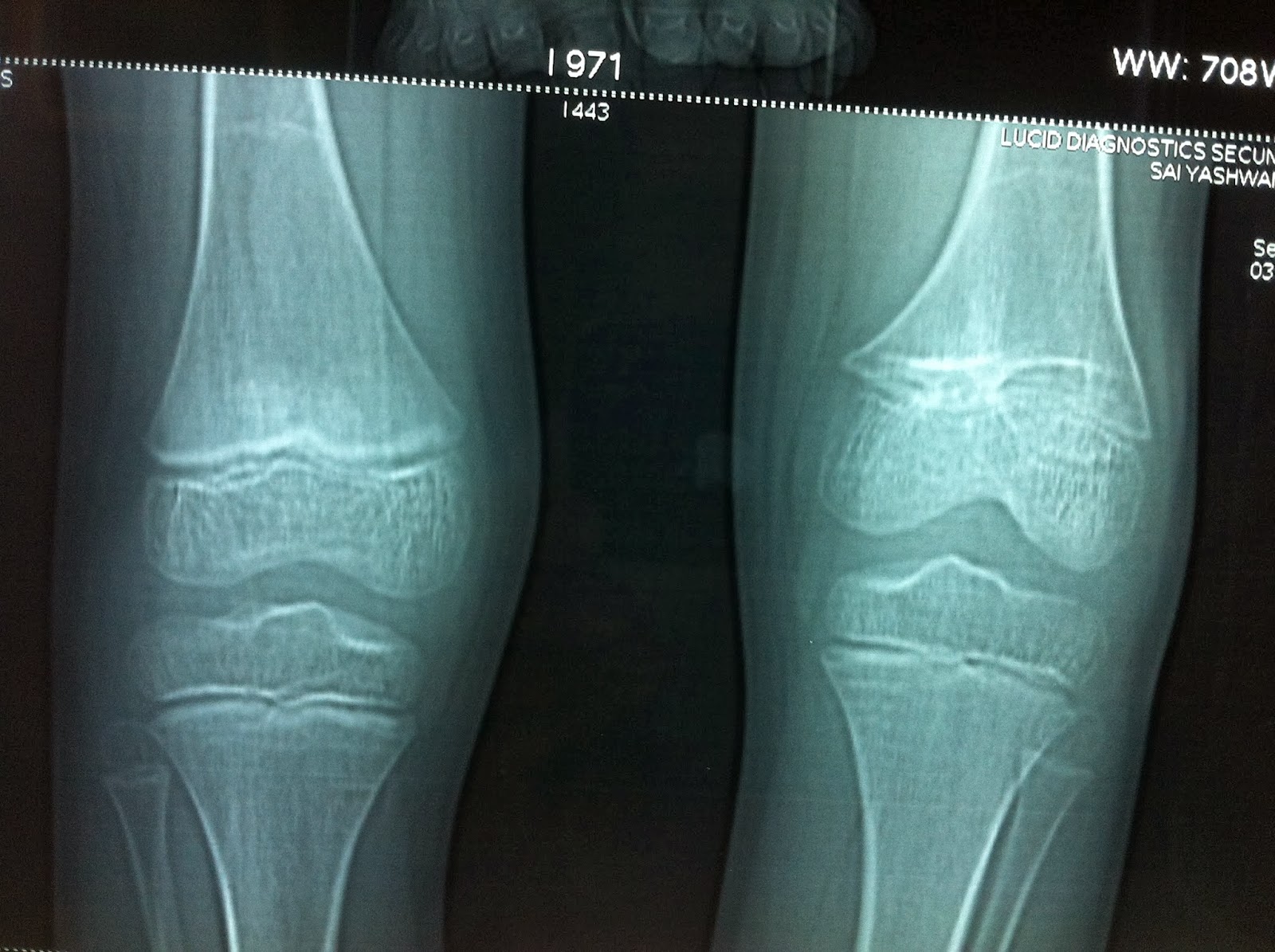1) Physiological bow legs in 18 months old child
 |
| Observation and followup is needed upto 2years |
2) Infantile Blount's disease in 4 yrs old child, note the abrupt bending on the left side
3) Left genu varum In 10 yrs old boy due to medial physeal arrest distal femur
Case 3 showing distal femur varus due to medial physeal tether
Case 3 CT scanogram demonstrating distal femoral genuvarum of 12* with limb length discrepancy of 1.5cms
 Case 3 MRI left knee showing tether in coronal and sagital planes
Case 3 MRI left knee showing tether in coronal and sagital planes
 |
| Physeal bar removed and bone cement used to pack the cavity |
Xrays of bilateral Infantile Tibia vara
 |
| Physiological knock knees in a 3.5 yrs old boy |
|
|
 |
| Idiopathic genu valgum in a 12 year old boy: note the distance between ankles | |
|
 |
| Incision for growth modulation |
 |
| Both sides medial 8 plates applied |
 |
| Post op dressings |
 |
| Immediate post op Xray: note screws are parallel |
 |
| 1 year post op xray: note screw divergence |
 |
| After full correction in a year : note the ankles are touching each other |
 |
| Blount's disease: Preoperative CT scannogram |
 |
| Preoperative pic of blount disease in a obese girl |
 |
| Postoperative left side correction after double osteotomy and lateral growth modulation |
 |
| Postoperative right side correction after double osteotomy and lateral growth modulation |
 |
| Postoperative correction achieved |
Introduction:
Genu varum or what we call in layman terms Bow legs is a very commonly encountered problem in pediatric orthopedic practice. It is usually the parents worry regarding the deformity which brings the child to the physician. Most common reason for this problem in a child below 2 years is physiological bow legs. This condition tend to correct spontaneously without any intervention by 2-3 years. Parents can be reassured regarding observation and serial measurement of intercondylar (between knees) distance to document progression or resolution. A word of caution to mothers who lend their ears to comments by family members, relatives and neighbors. It can be extremely stressful in certain situations where family members fail to understand the problems and blame it on to mother. As long as the child is below 2 years, growing normally, reaching milestones necessary for that age and does not have pain, do not panic.
Of course there are other causes of bow legs as mentioned below but most of them are treatable and correctable.
- Rickets most commonly seen due to nutritional Vit D deficiency followed renal, genetic and tumor problems
- Blount's disease
- Skeletal dysplasia : achondroplasia, multiple hereditary exostosis, fibrocartilaginous dysplasia
- Congenital : Tibial hemimelia
- Trauma : physeal fractures, iatrogenic
- Infection : Osteomyelitis, septic arthritis
- Idiopathic
Beware of condition which can mimic or exaggerate the deformity such as tibial intorsion, malunited fractures. Always consult your physician if any of the findings below are present:
- Persistence or deformity above 3 yrs
- Progression
- After trauma
- Family history
- Pain
- Unilateral
- Severe deformity
- Obese child
- Shortening of leg
Physiological bow legs correct without the need of braces or treatment.
Rickets can be corrected by giving Vit D and calcium supplements.
Most of the other condition needs surgical intervention in the form of guided growth, corrective osteotomy or physeal bar resection.
The photos posted here are my own patients. This post is for parents and family who have similar problems, any query can be mailed to me at drsagar_c@yahoo.com
 |
| Thanks to their mom for taking this pic with beautiful two little twin angels |
Regards and stay healthy....it should not hurt to be a child

 Case 3 MRI left knee showing tether in coronal and sagital planes
Case 3 MRI left knee showing tether in coronal and sagital planes




















No comments:
Post a Comment